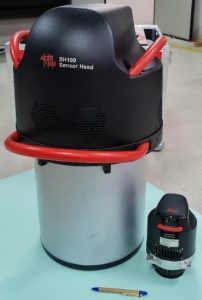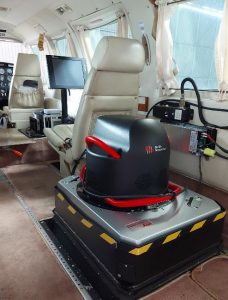
Zoom and part of the Pixel Carpet from ESTEIO’s ADS100 sensor – GSD 5cm – 20.000 x 186.648 pixels · 3.778 Mpix – Curitiba
One of these days, I was talking to a member of ANEA about a client that demanded a large-format airborne digital camera in their bidding process. My colleague categorically stated that his company did have such an equipment, since their camera displayed a resolution of 100 megapixels – Mpix. I had to respectfully disagree! Even though a sensor with this resolution has already been considered as large format, nowadays there are cameras with more than 100 Mpix in some smartphones, which, in this case, are far from being considered as large format. However, in aerophotogrammetry, distinguishing between medium- and large-format is not an easy task.
The concept of “large format” emerged at the time of analog cameras and was related to the image’s frame size or negative. Aerial cameras bearing a 23 x 23 cm frame were considered to be large format. When the first digital airborne sensors appeared, they were all considered large format, even though none of them would achieve a resolution that was on par with the best analog aerial cameras at the time. A few years later, the market was taken by cameras of lower cost, smaller size, and less technological resources – the so-called medium-format digital aerial cameras, which mainly operated alongside LiDAR sensors and for corridor mapping purposes. According to Dr. Michael Cramer*, professor at the University of Stuttgart, nowadays, an aerophotogrammetric camera that provides images having around 400 Mpix seems to be large format, because its resolution is comparable with a digitalized or scanned image obtained by the last film-based aerial cameras.
In 2002, Z/I Imaging Corporation – a merger of the German Carl Zeiss with the American Intergraph – launched their first large-format airborne camera: the DMC. It was a frame digital aerial camera, bearing four multispectral CCD sensors with a resolution of 6 Mpix, four 28-Mpix panchromatic sensors, and eight lenses, wherein, after fine processing, the final image displayed a resolution of 104 megapixels. In 2021, the large-format camera Leica DMC-III, the evolution of the DMC of the extinct Z/I, now with five CMOS sensors and five lenses, is able to deliver multispectral images with a resolution of 375 megapixels.
Although the frontier between medium and large format is not very well defined, according to Dr. Cramer, medium format typically involves only one sensor pointed at the nadir, without the addition of other sensors to increase the footprint, and, also, without the presence of additional sensors or heads for color information. Thus, the nadir view generally presents the Bayer pattern for obtaining a color image. The Bayer filter, matrix or pattern is a resource through which only one sensor, CCD or CMOS, is used for collecting the RGB image, wherein 25% of the pixels record the red band, 50% record the green band, and 25% record the blue band, thereby making up the RGB image. Prof. Cramer also explains that, unlike a medium-format airborne camera, a large-format one has additional nadir sensors for two main reasons: first, to increase the footprint using many adjacent subimages so as to compose an image with larger coverage. The second reason is to bring additional sensors together to record distinct spectral bands, therefore gathering images of better radiometric quality, showing the much desired, and real, color separation.
On the Brazilian market, today, there are three main active brands of aerial cameras: Hexagon-Leica, Vexcel, and PhaseOne. The Swiss Leica Geosystems AG presents on their website the sensor MFC150 as medium format, and it produces 150-Mpix images. The Austrian Vexcel Imaging GmbH commercializes various large-format cameras, including the 450-Mpix UltraCam Eagle Mark-III. The Danish PhaseOne A/S only considers their 280-Mpix iXM-RS 280F sensor to be large format. Their second-best model, iXU-RS1900, slightly simpler and also displaying two sensors and two lenses that produce 190-Mpix images, is considered medium format.
Noticeably, although it is an important feature, the number of pixels on the footprint is not the only characteristic that will determine whether an aerial camera is large format or not. In 2003, the Vexcel UltraCam D camera, precursor of the UltraCam Eagle and undoubtedly considered large format at the time, would only provide 86-Mpix images. If we only have the number of pixels in mind, today’s large format may be tomorrow’s medium format, and the future’s small format.

Another evident characteristic is the difference in weight to be carried on board. A large-format system, head sensor and peripherals, may be ten times heavier than a medium-format one. The image on the right illustrates well the difference in size between a large- and a medium-format sensor – the sensor head SH100 of the Leica ADS100 and the RCD30 camera: one with 48 kg and the other with 4 kg, both by the same manufacturer and operated by ESTEIO. The terms small-, medium-, and large-format** have long been part of the lexicon of many users, both photogrammetrists and sympathizers, and will not likely disappear. However, in order to avoid mistakes in interpretation when specifying or requiring the “format” of an aerial camera, some minimal desired features should be added.
It seems correct to state that the aerophotogrammetric definition of large format changes with time, and it will always be the “largest” footprint available on the market, which has been incorporating large-format digital cameras and sensors ever since the year 2000. Many are still operational and providing high geometric accuracy and high radiometric quality images. Their accuracy, performance, quality and resolution are not only a result of the thousands of pixels, but also – and sometimes solely – of the additional technological resources associated to the CCD or CMOS image sensors.
A common question by many Brazilian contractors is what kind of imaging should require a large-format camera and where would a medium-format one suffice. Again, this question does not have an easy answer. What can be said is that, in most cases, images collected by a large-format camera will always be better than those by a medium-format one, which, in turn, will be better than a small-format camera. However, many elements should and must be taken in consideration, such as operation deadline, estimated cost considering further steps, geometric accuracy and, mainly radiometric quality, and so on. It is worth mentioning that, in larger areas, it is common for imagery made with a large-format camera to be less expensive than one with a medium-format camera, and that, moreover, the higher cost may offer greater benefit.

ESTEIO, over their more than 50 years on the market, has acquired and operated a variety of aerophotogrammetric sensors, wherein four are medium-format digital cameras, six analog cameras, and three large-format digital sensors. Their most recent acquisition was the Leica ADS100. ADS is an acronym for Airborne Digital Sensor, and the 100 and 120 versions are part of the fifth generation of this line of sensors, launched in 2001 with the ADS40. The Leica ADS100 is one of the most modern sensors available on the market, with over 120 kg of the highest technology on board, mainly featuring the following resources:
- Thirteen linear sensors for continuous imaging with 20,000 pixels across track. Three lines of sensors for the Red band, four lines for the Green band, three lines for the Blue band, and three lines for the Near Infrared spectral band;
- Simultaneous recording of distinct bands: Red, Green, Blue, and NIR (R = 619-651 nm, G = 525-585 nm, B = 435-495 nm, and NIR = 808-882 nm), correlated with the use of 3 Tetrachroid filters and without the use of the pan-sharpening resource (RGB sampling over pan-chromatic pixels), which is common in frame digital cameras;
- Sensors with the novel TDI (Time Delay Integration), the digital alternative of the very well-known mechanical Forward Motion Compensation (FMC);
- Three R, G, B, and NIR views, backward with 19°, nadir with 0°, and forward with 26°, simultaneously creating one nadir image strip and two oblique ones;
- Three stereoscopic pairs per strip;
- Unique telecentric lens with thermal and pressure compensation for high accuracy, designed and manufactured exclusively for photogrammetric use, wherein the telecentric design maintains the position and width of the filter edges over the field of view;
- High performance gyro-stabilized sensor mount with adaptive control PAV100-HP, responsible for precise stabilization of the sensor during the flight, and with the additional possibility of shared use with the SH120 sensor head, LiDAR sensor, bathymetric sensor, oblique system, or medium-format camera;
- Memory capacity of 2,4 Terabytes and interchangeable during the flight;
- Ability to obtain high-resolution images with ground resolution (GSD) of up to 3 cm;
- High-performance inertial system, efficient software for flight management, and so on.

Backward (19°), Nadir (0°) and Forward (26°) RGB images from one of the first flight strips with ESTEIO’s ADS100 sensor – Curitiba
Since imaging is continuous – feature of the linear sensor also known as pushbroom –, ESTEIO’s new Leica ADS100 sensor is able to record 20,000-pixel nadir images by a number of pixels which is only limited by the flight time. The frequent question about the number of megapixels of the ADS100 sensor can be answered as follows: even though the megapixel resolution is an exclusive feature of frame cameras, if we imagine a square image, as those recorded by analog cameras, we will have a resolution equivalent to 400 Mpix; if we imagine a 3×4 image, we will achieve 553 Mpix; and if we consider the real size of the image, scene or strip, also known as “pixel carpet” – first image in this article –, we may achieve thousands of megapixels or several gigapixels depending on the aircraft’s speed and on the GSD.
Therefore, the ADS100 is an excellent representative of the current large-format sensors available on this restrict and select market of digital airborne sensors.
* Dr. Michael Cramer is an engineer, researcher, professor, and head of the Research Group of Photogrammetric Systems in the Institute of Photogrammetry at the University of Stuttgart, in Germany. On a personal e-mail conversation at: valther@esteio.com.br on Feb. 19, 2021.
** The terms small-, medium- and large-format are part of the photography history. Although digital cameras have overtaken analog ones, analogue cameras still exist and are used by a very small number of film photography aficionados. Large-format cameras were the first to appear, they had several frame sizes, the smallest being 4 x 5 inches, this size of film is sold in sheets and has been around since 1830. Small-format cameras use roll film and mainly the standard 135 – released in 1934 by Kodak, with a frame size of 24 x 36 mm or smaller. A medium format camera originally used the so-called “120” film size – available since 1901, would typically take 60 mm by 45 or 60 mm. In the transition to the digital era, medium format “back ends” have all been designed with diagonal dimensions small enough to utilize lenses originally designed for use with “120” film. Of course, nowadays, even the lenses are redesigned to accommodate the special characteristics of digital focal planes, but the nomenclature persists. Contribution received by e-mail from Ron Roth of Hexagon-Leica USA.
Valther Xavier Aguiar is a cartographic engineer, Chief Technical Officer of ESTEIO Engenharia e Aerolevantamentos S.A. and
President of ANEA – Associação Nacional de Empresas de Aerolevantamento.
valther@esteio.com.br, www.esteio.com.br, Mar/21

All rights reserved. Copyright 2021, ESTEIO Engenharia e Aerolevantamentos S.A.
